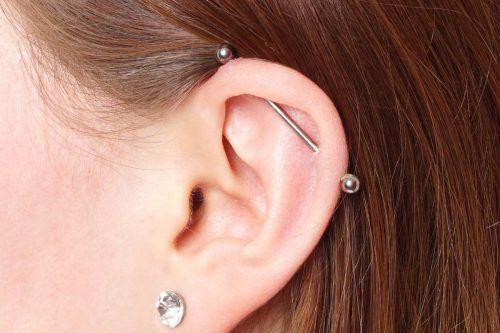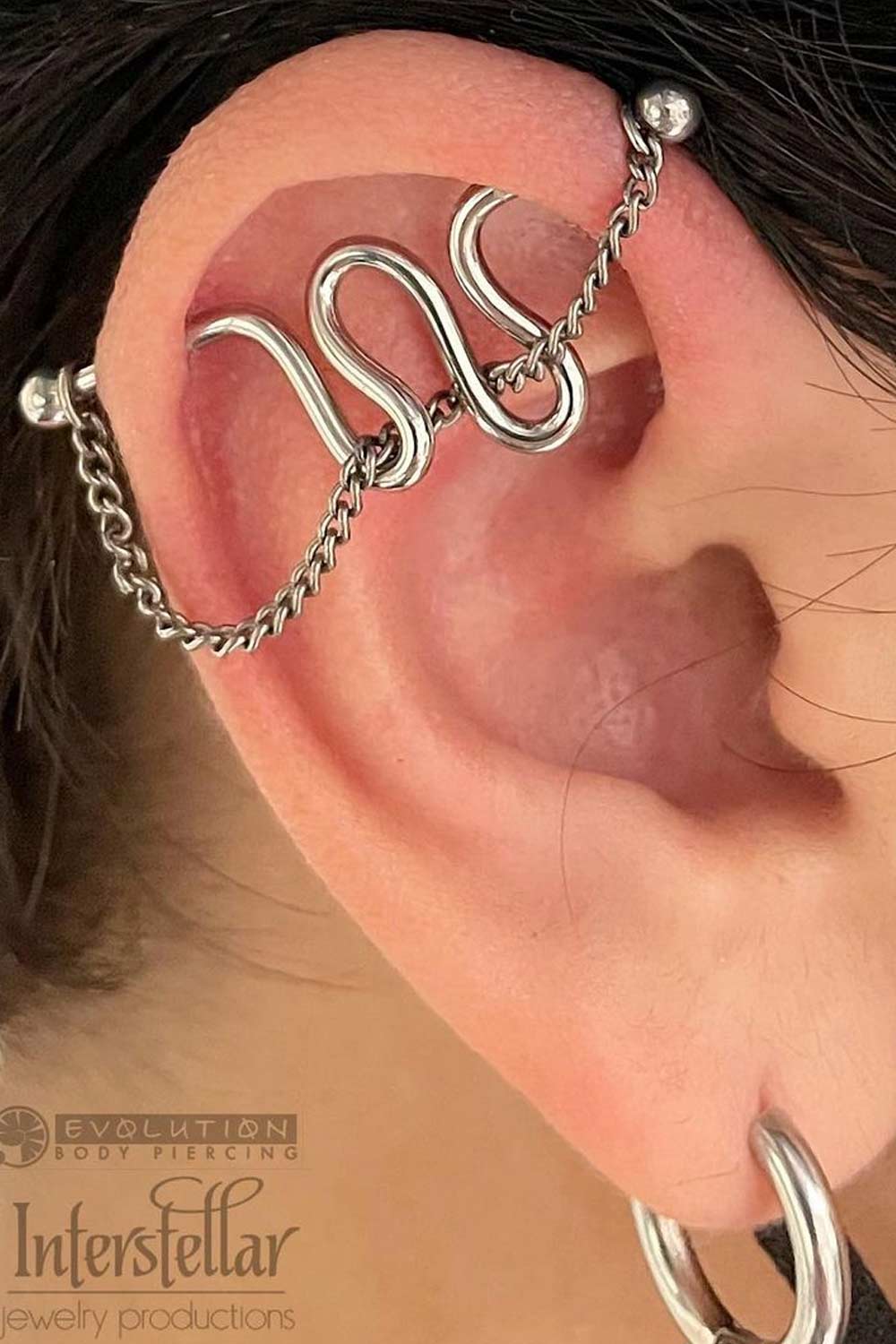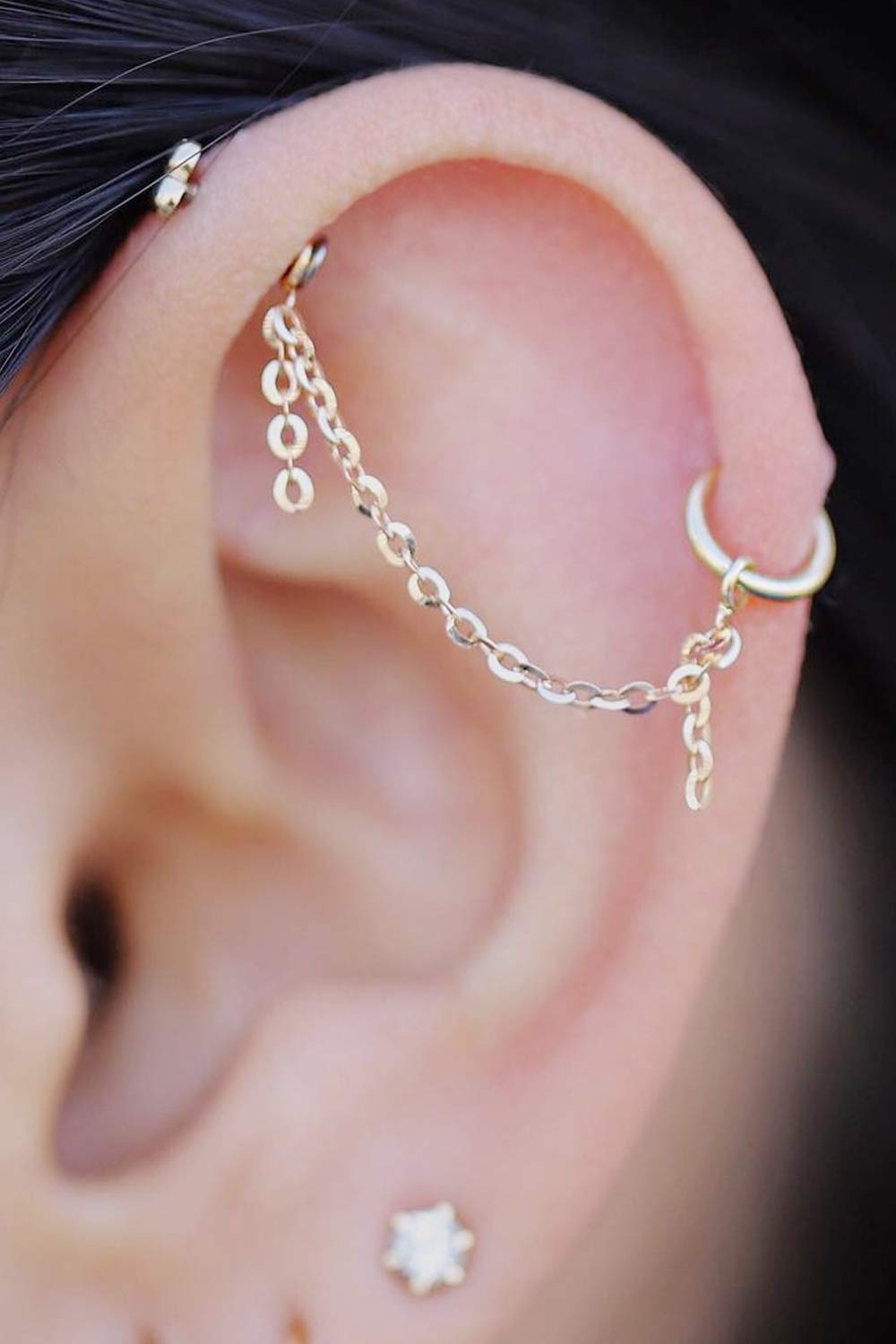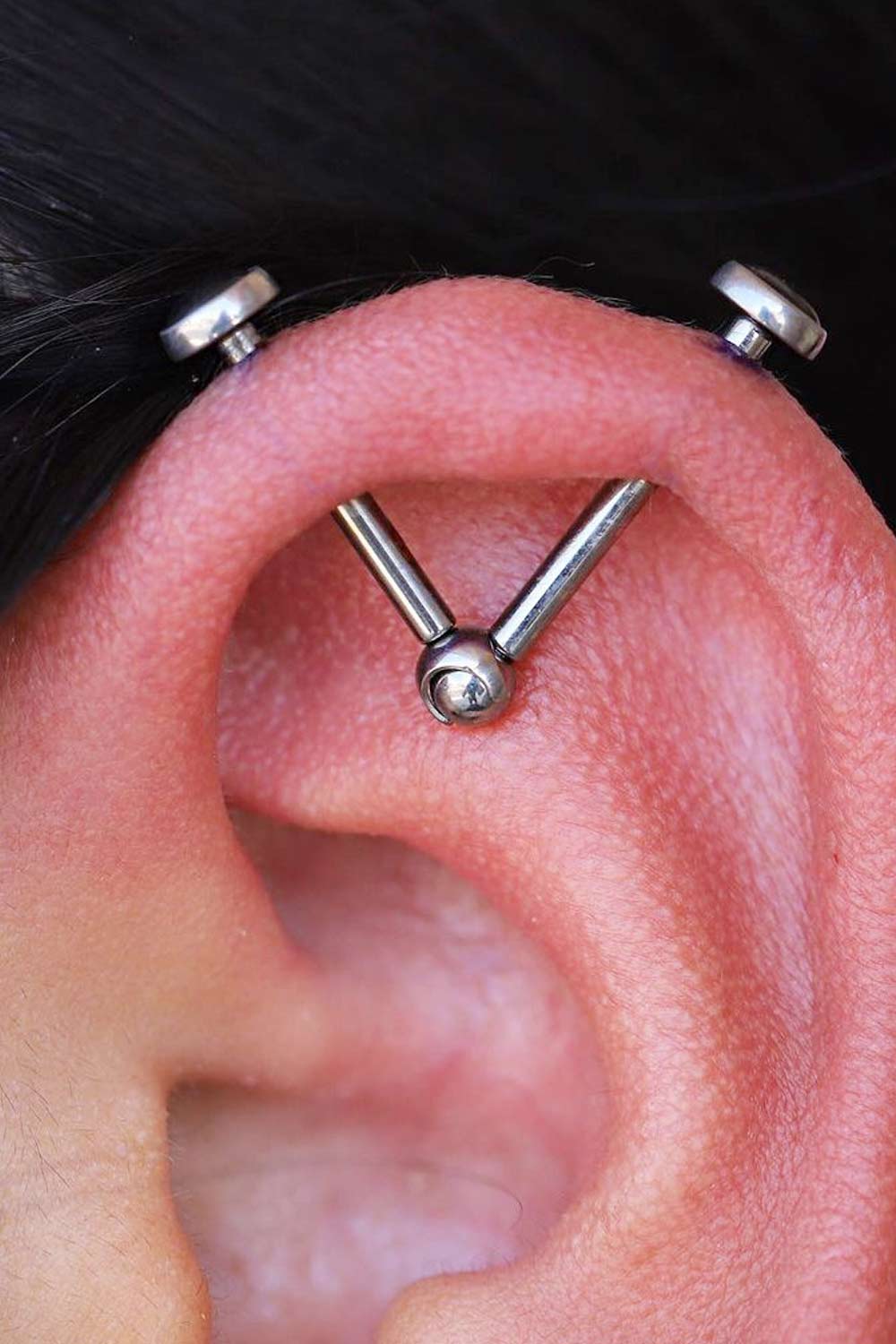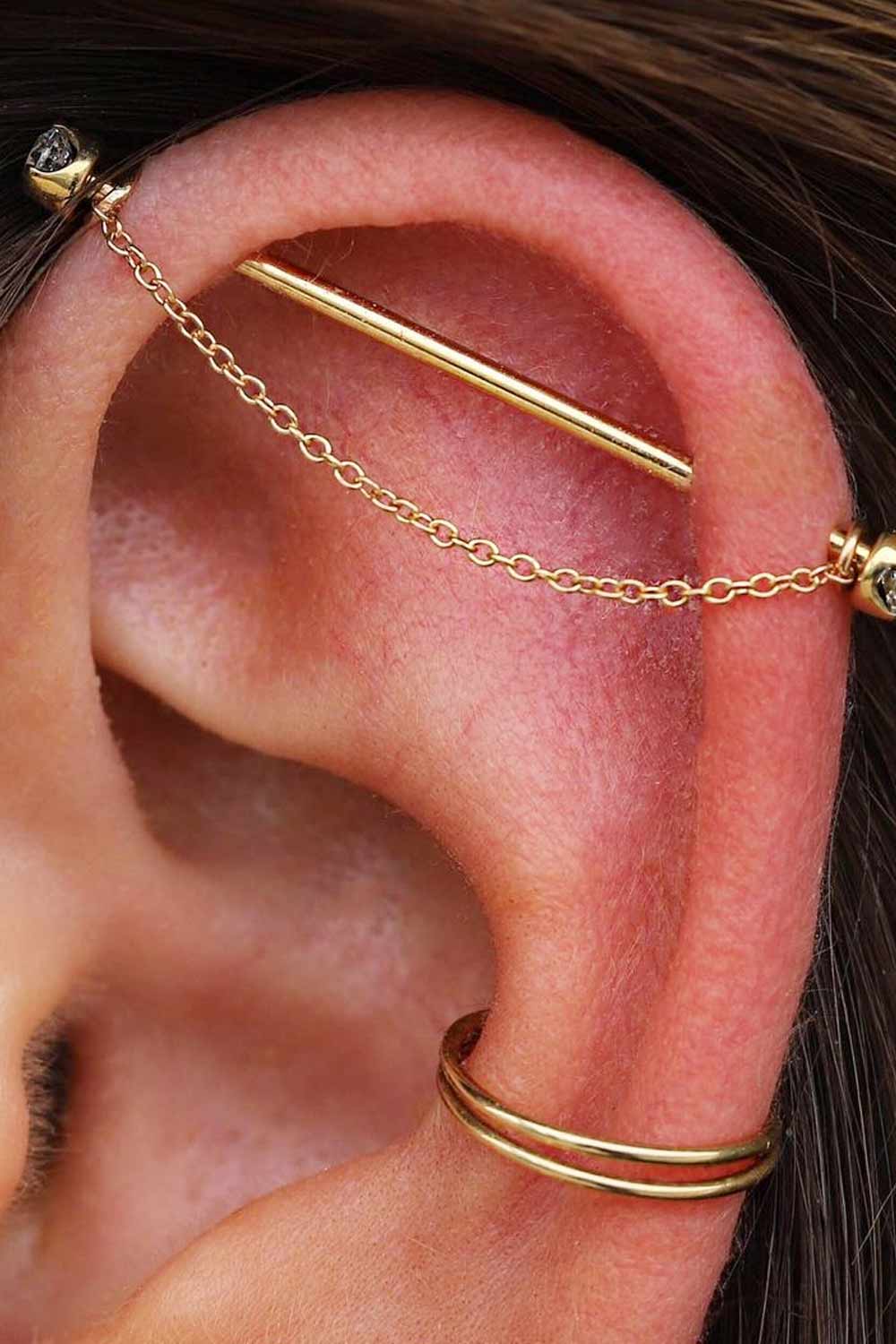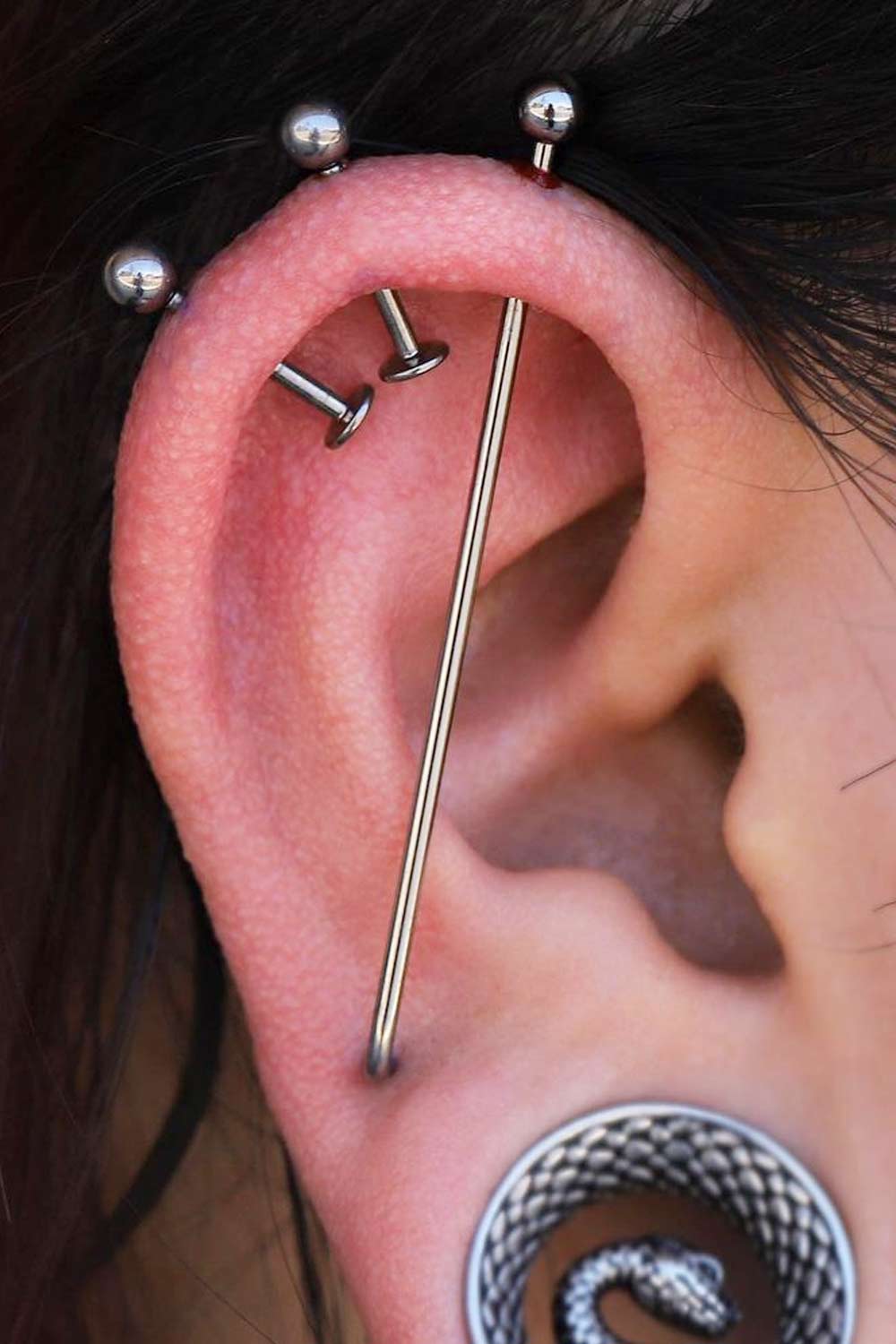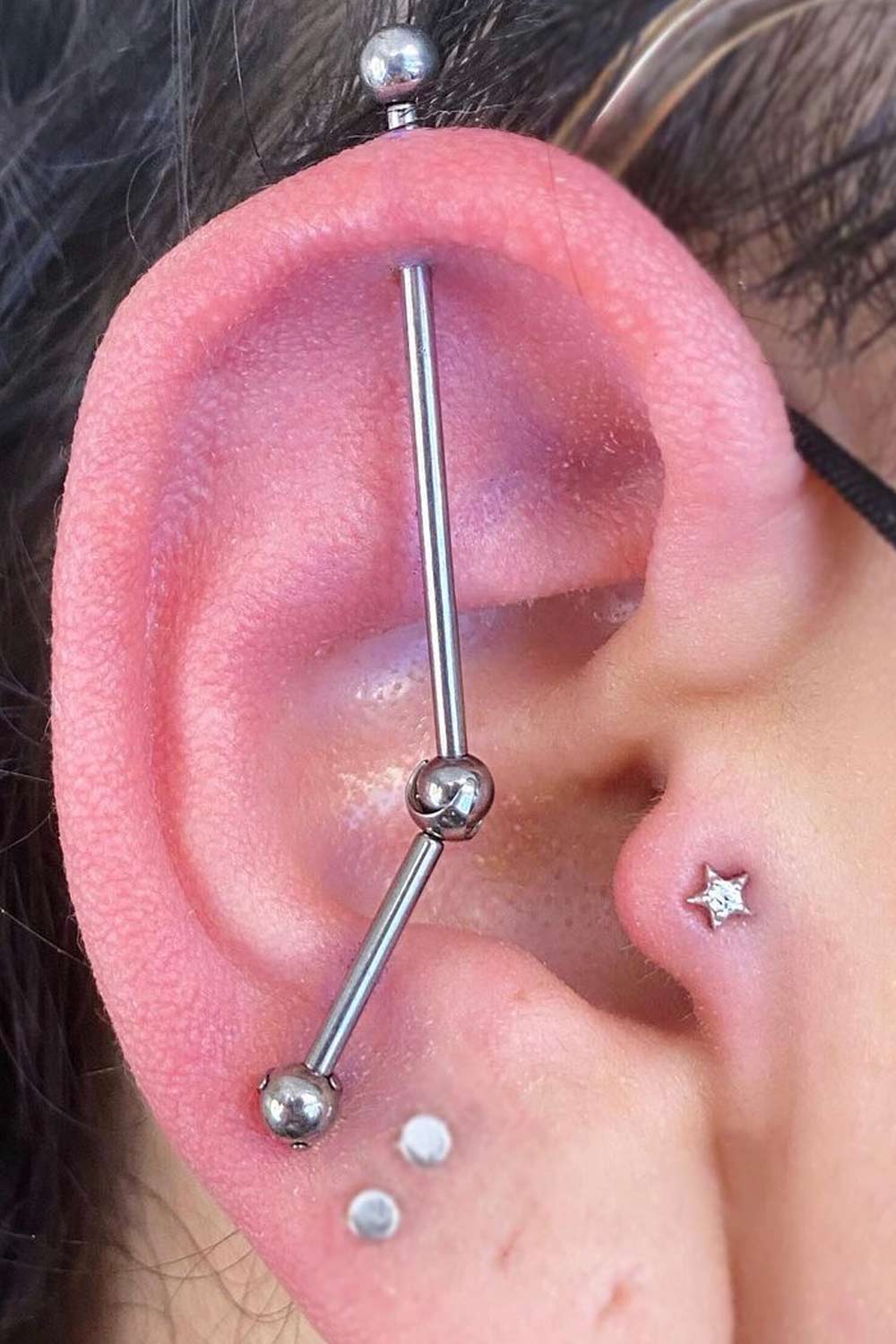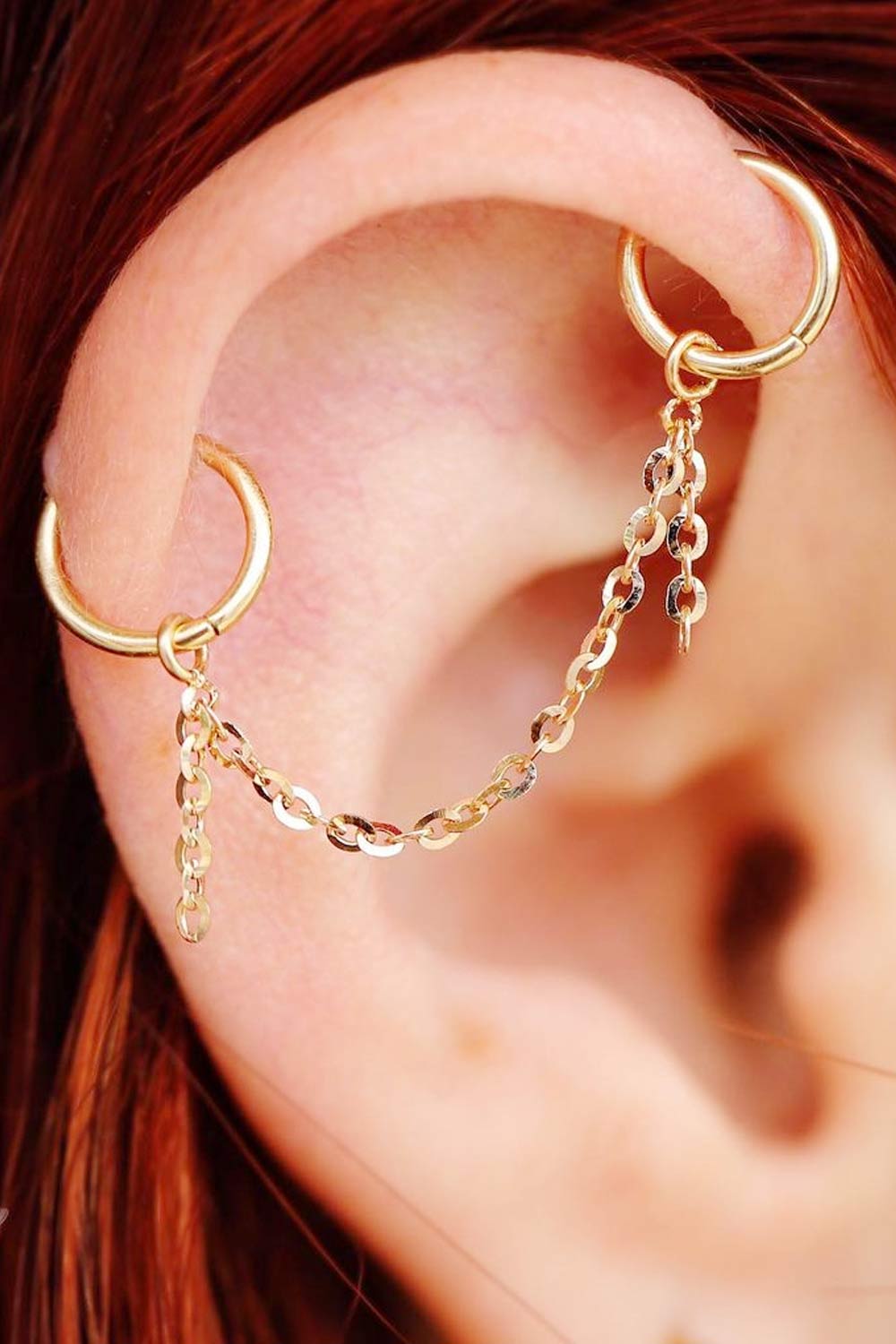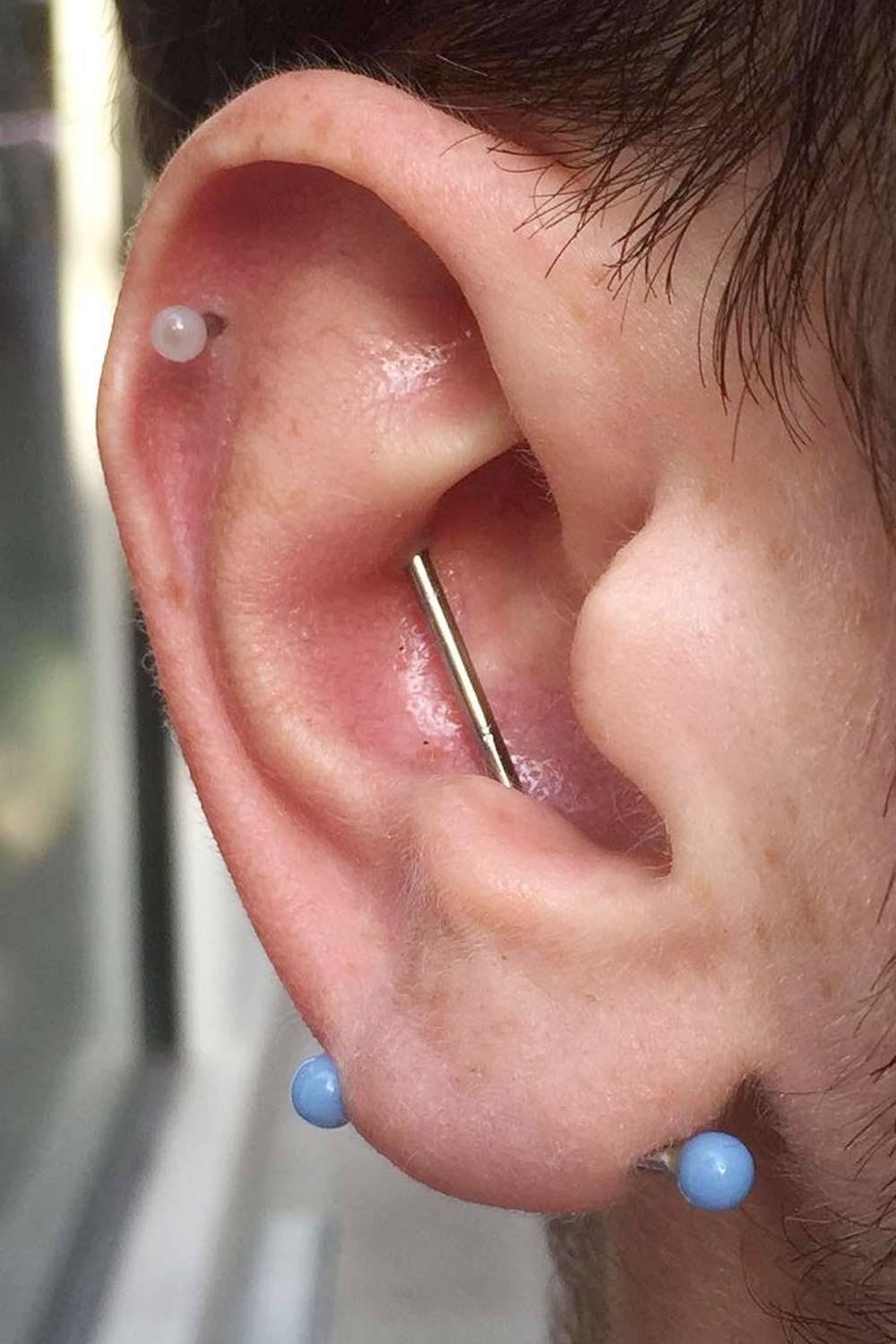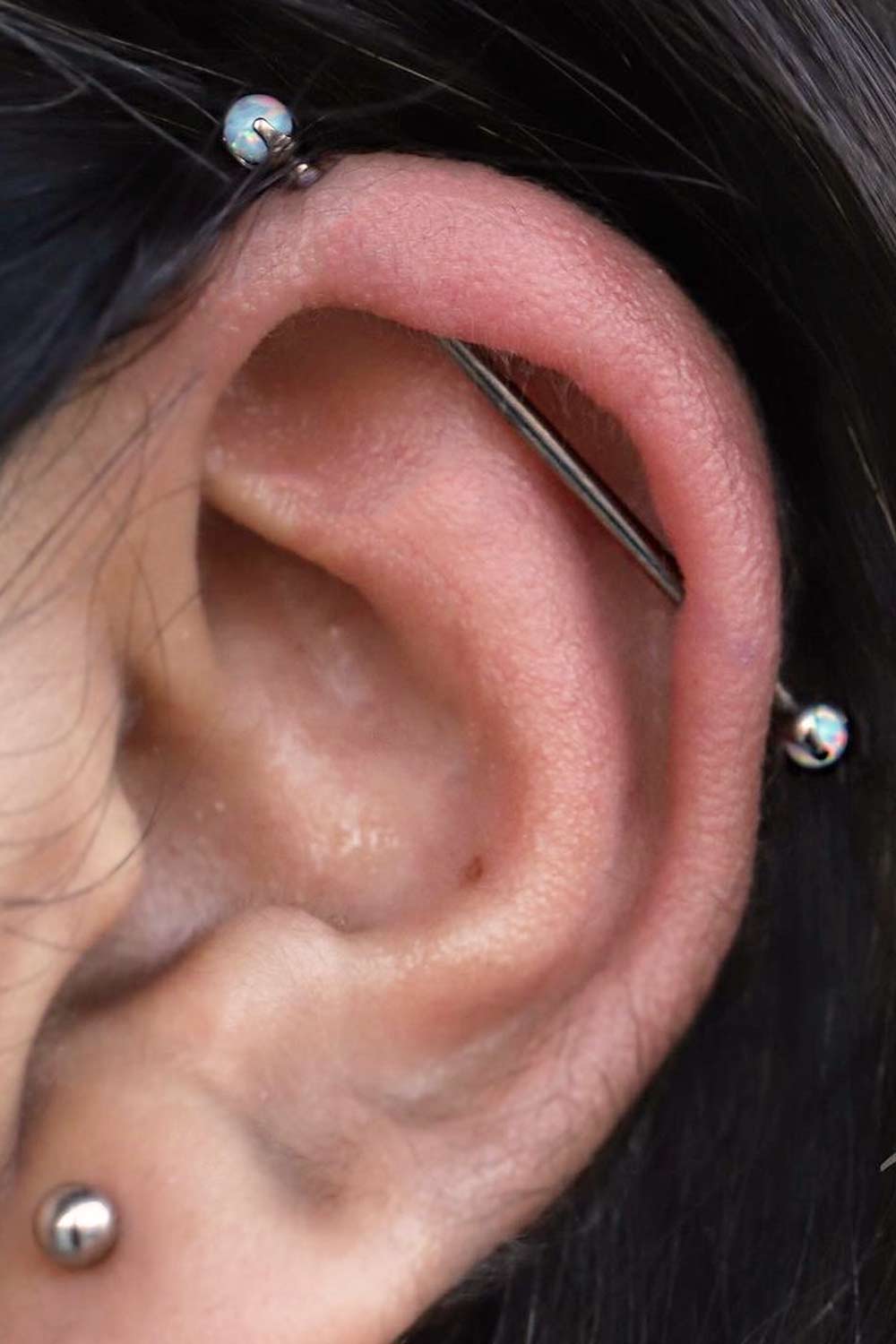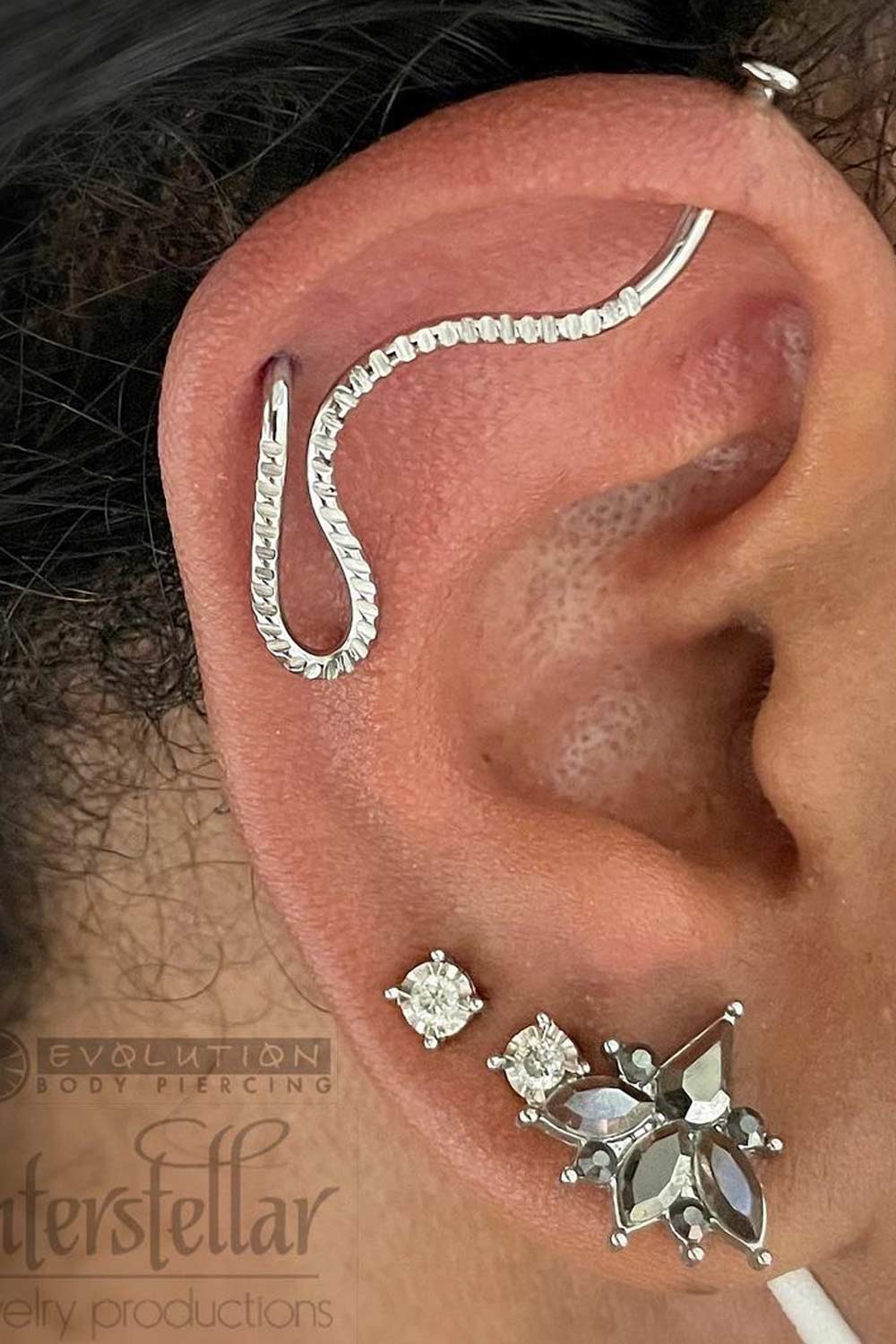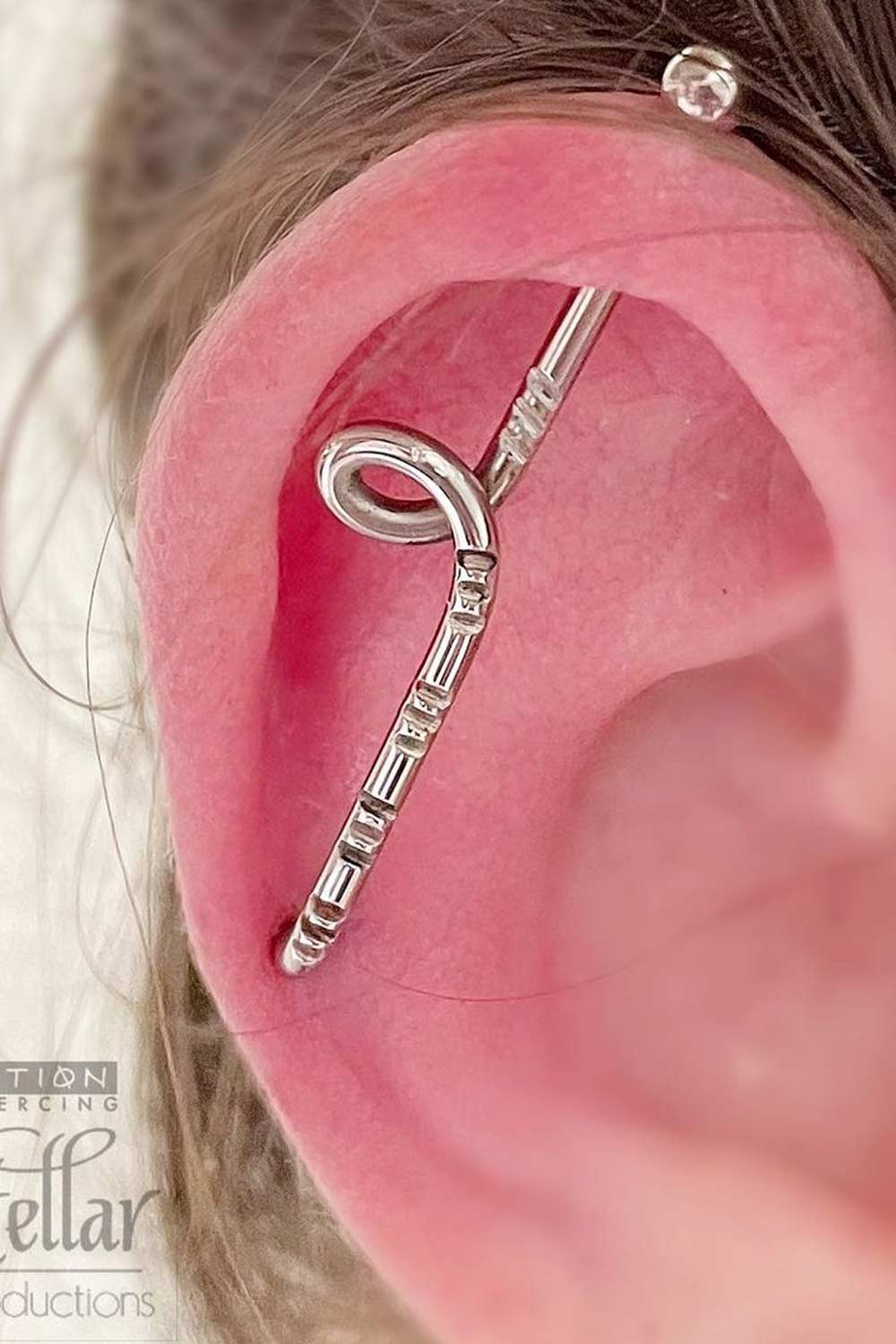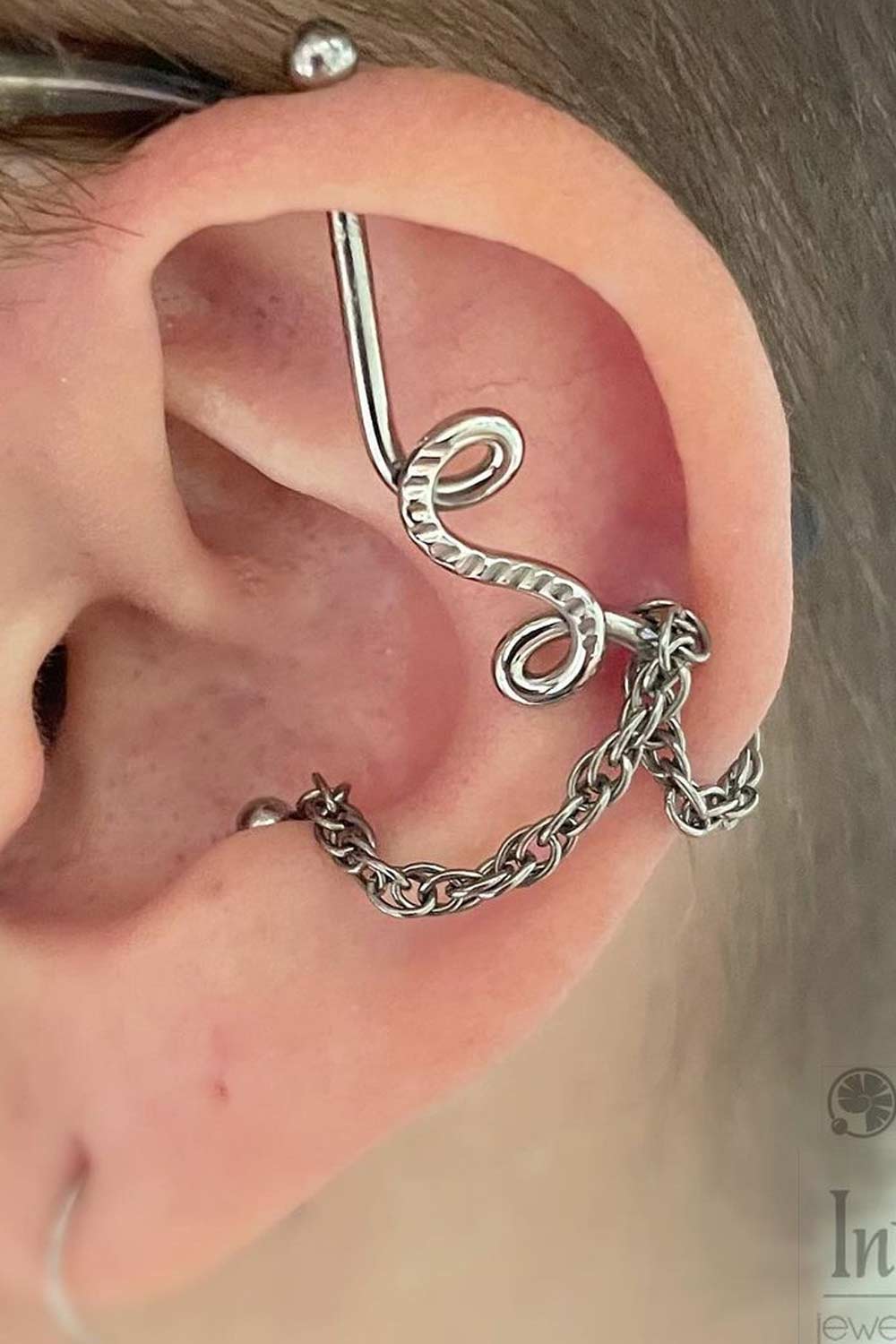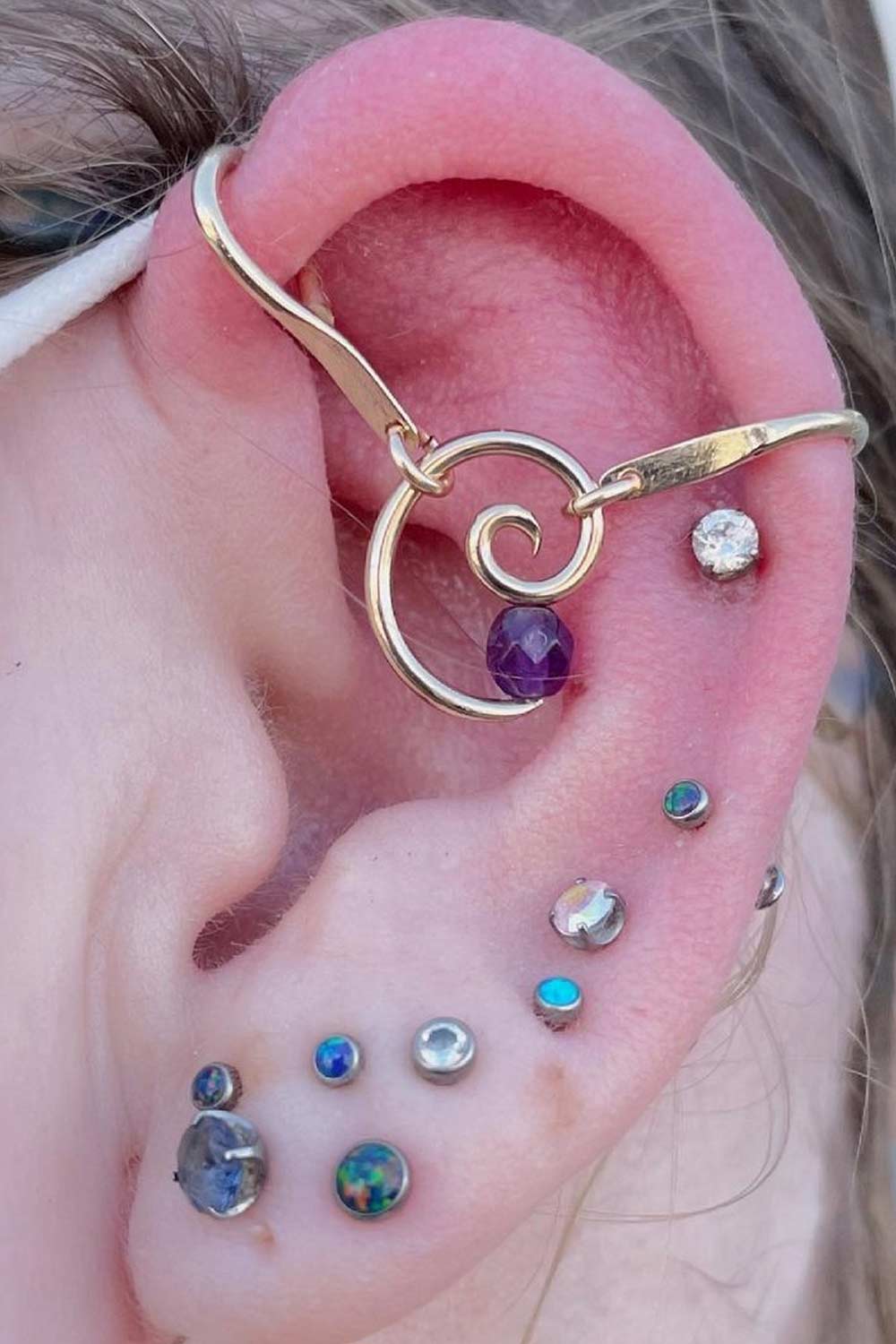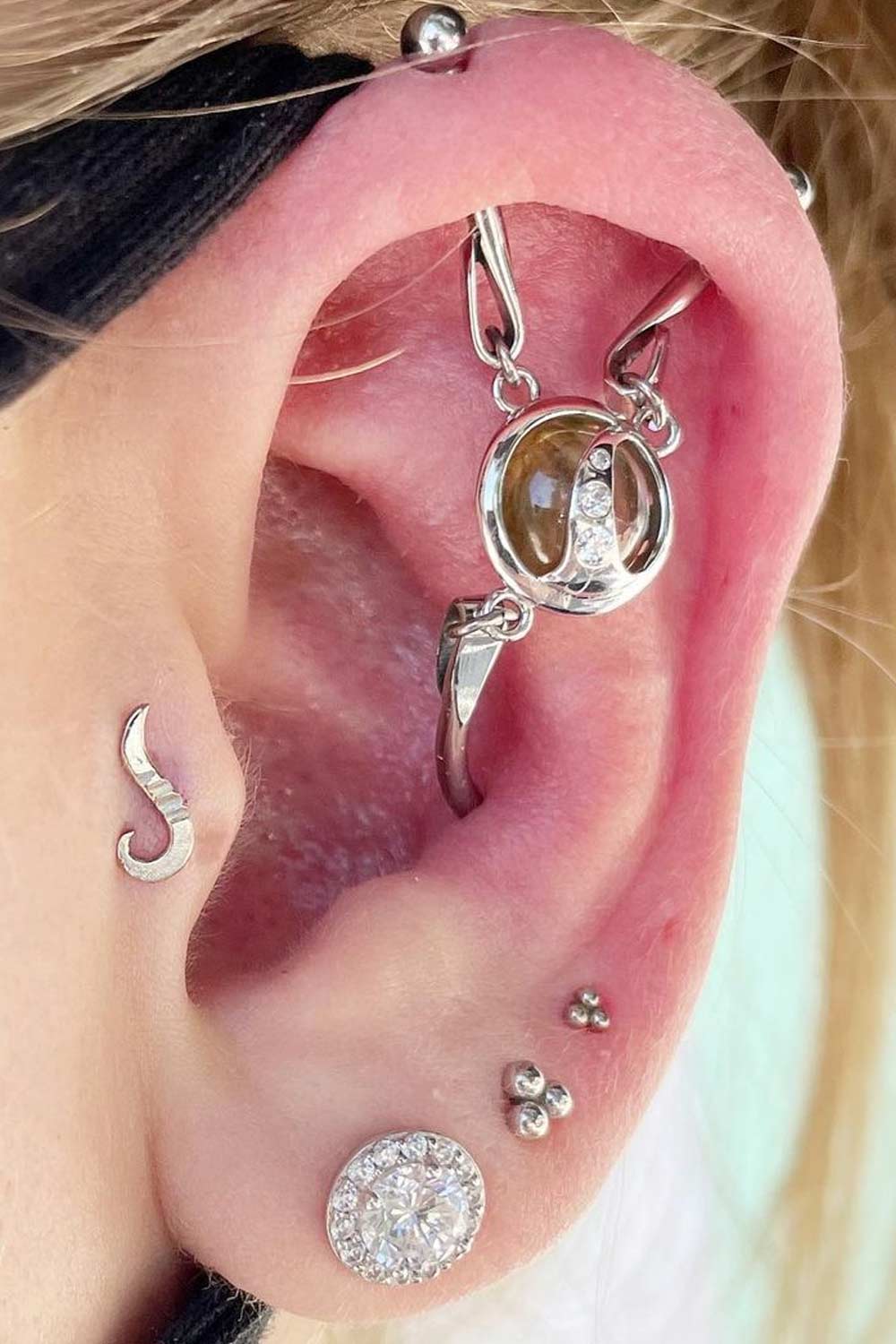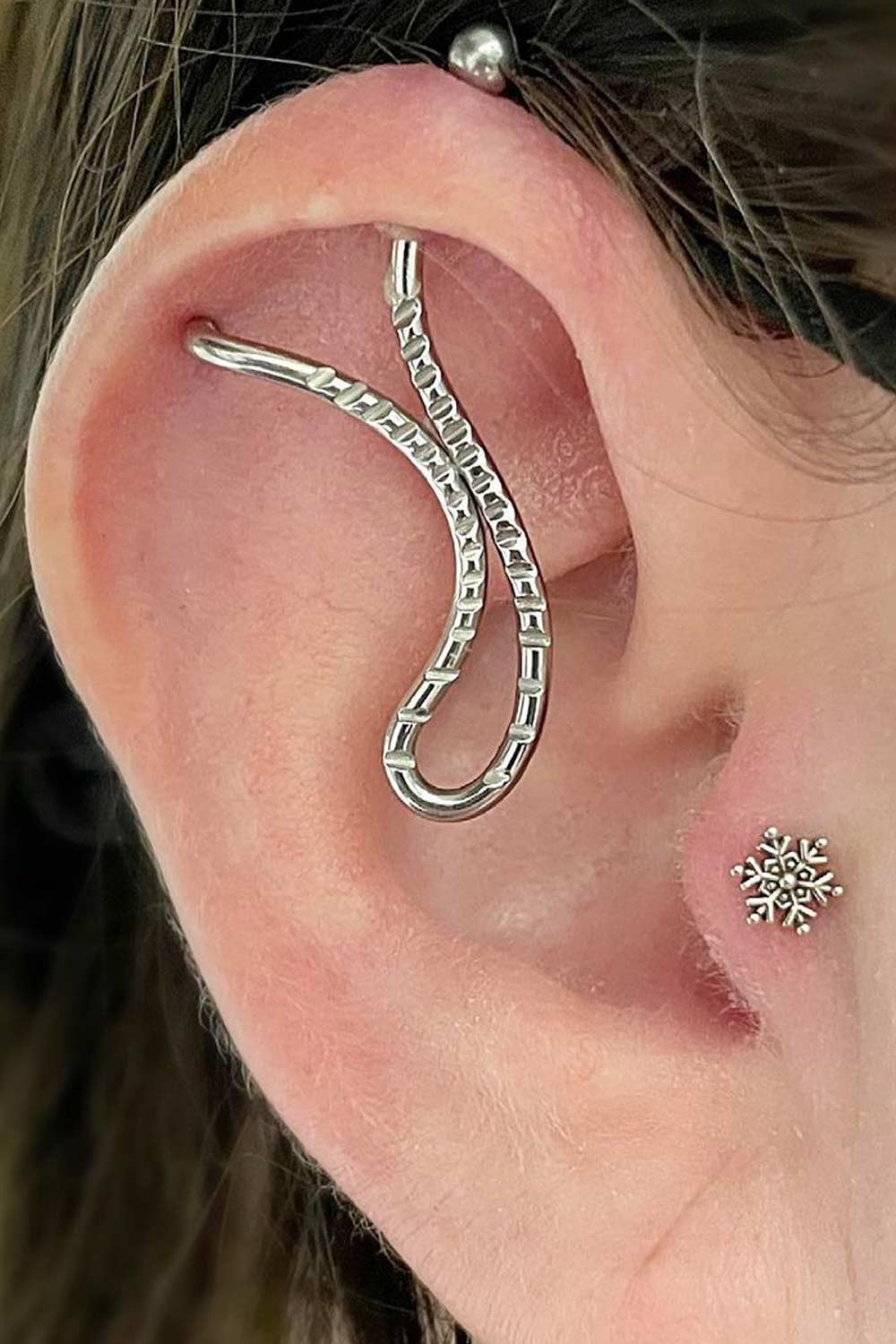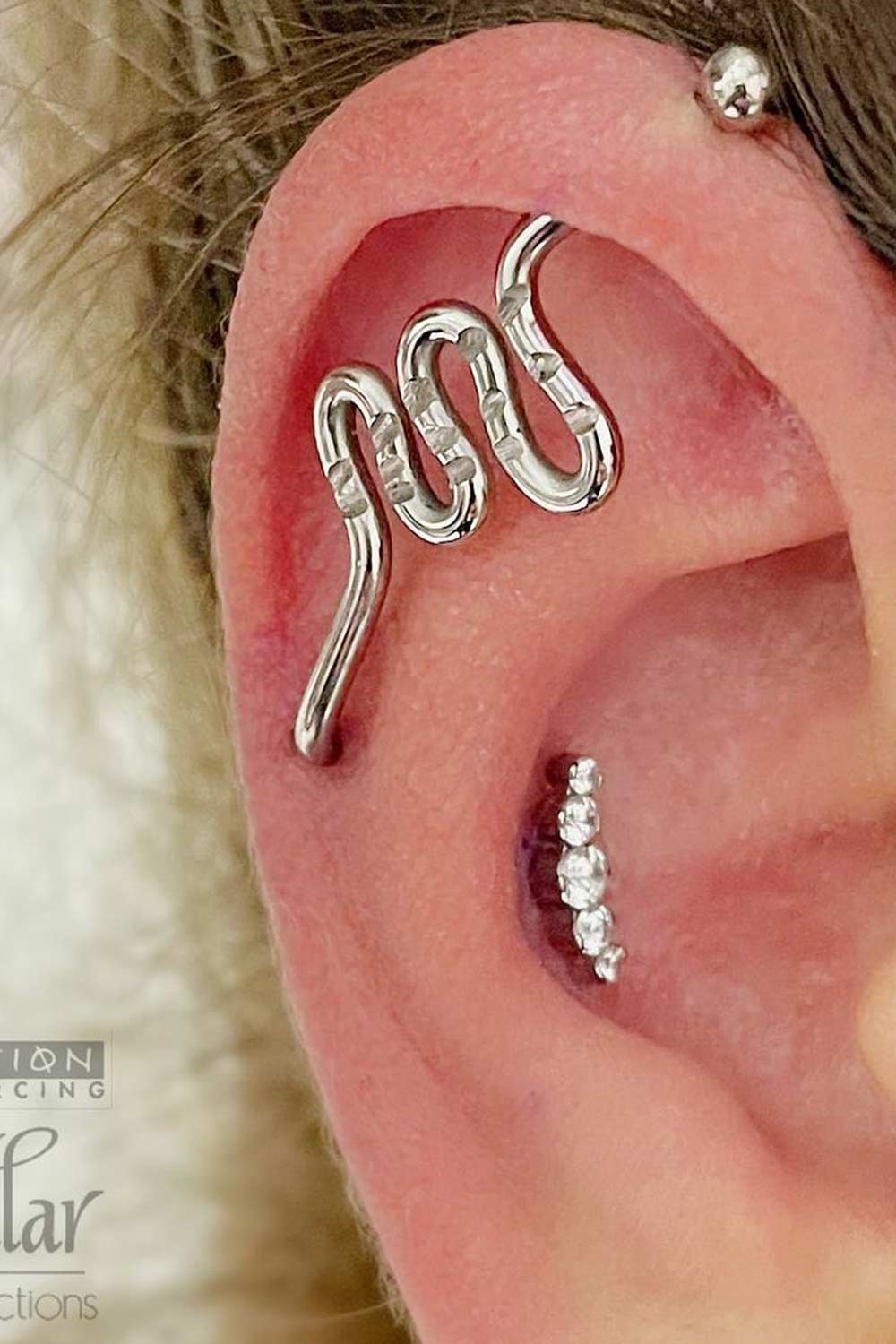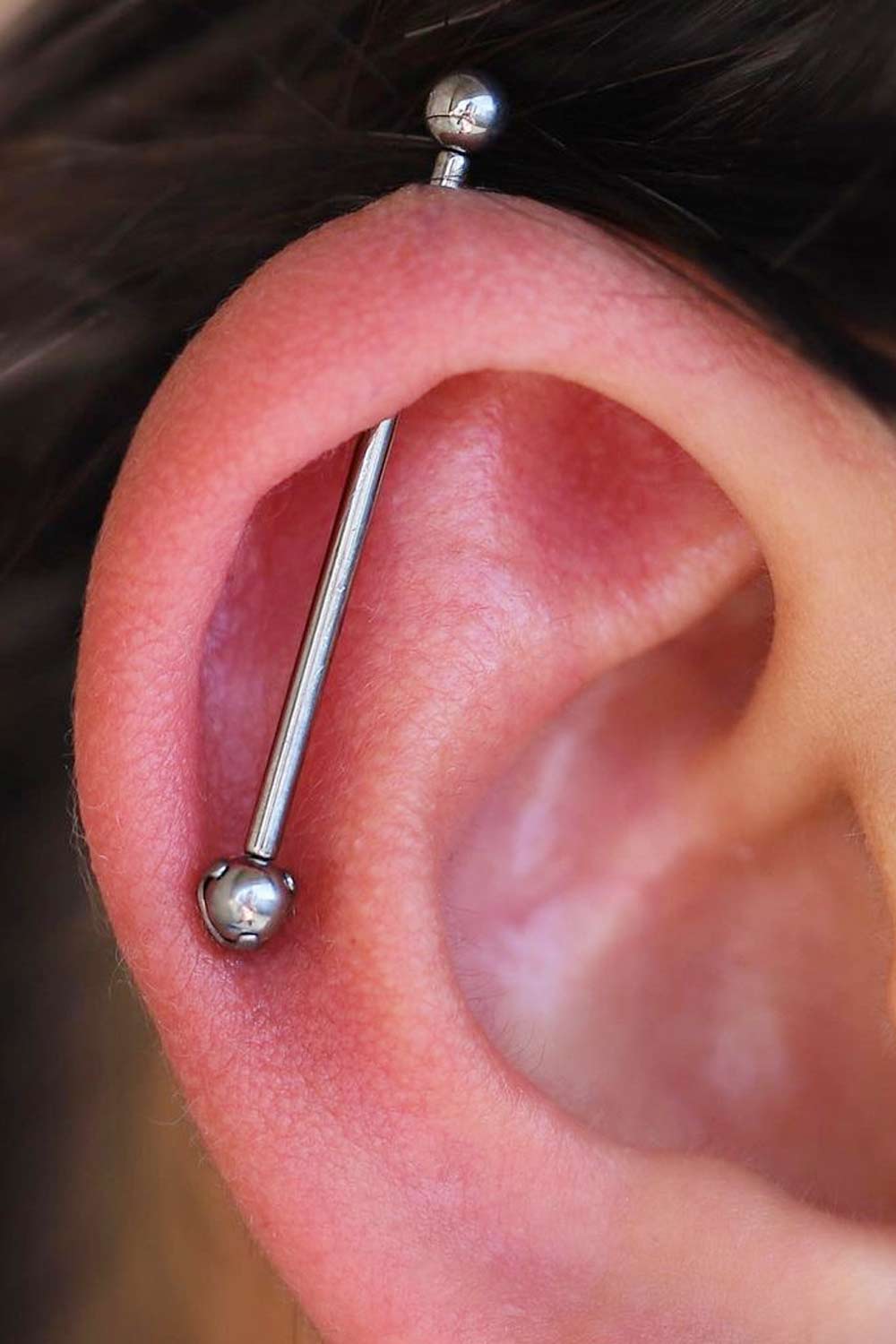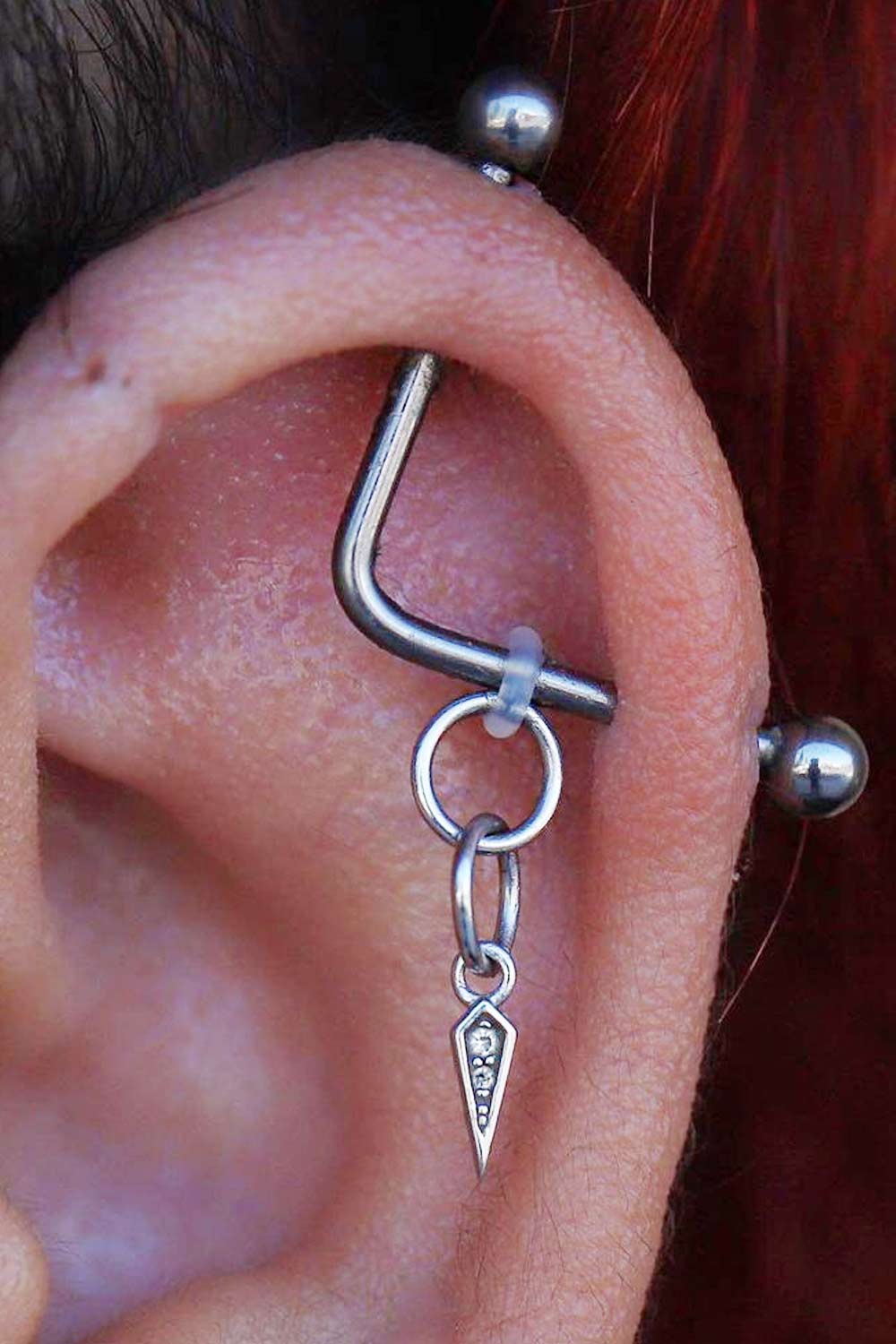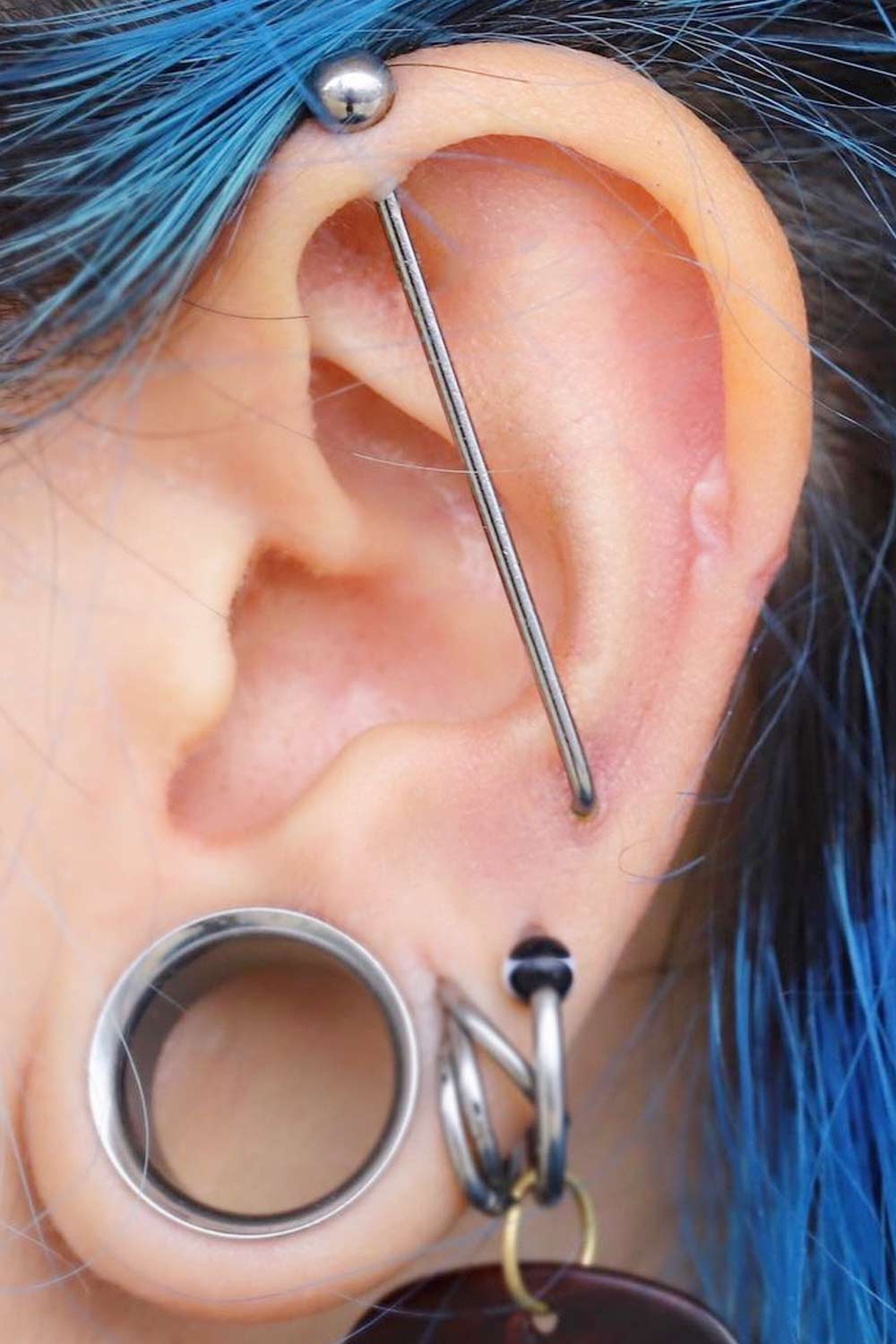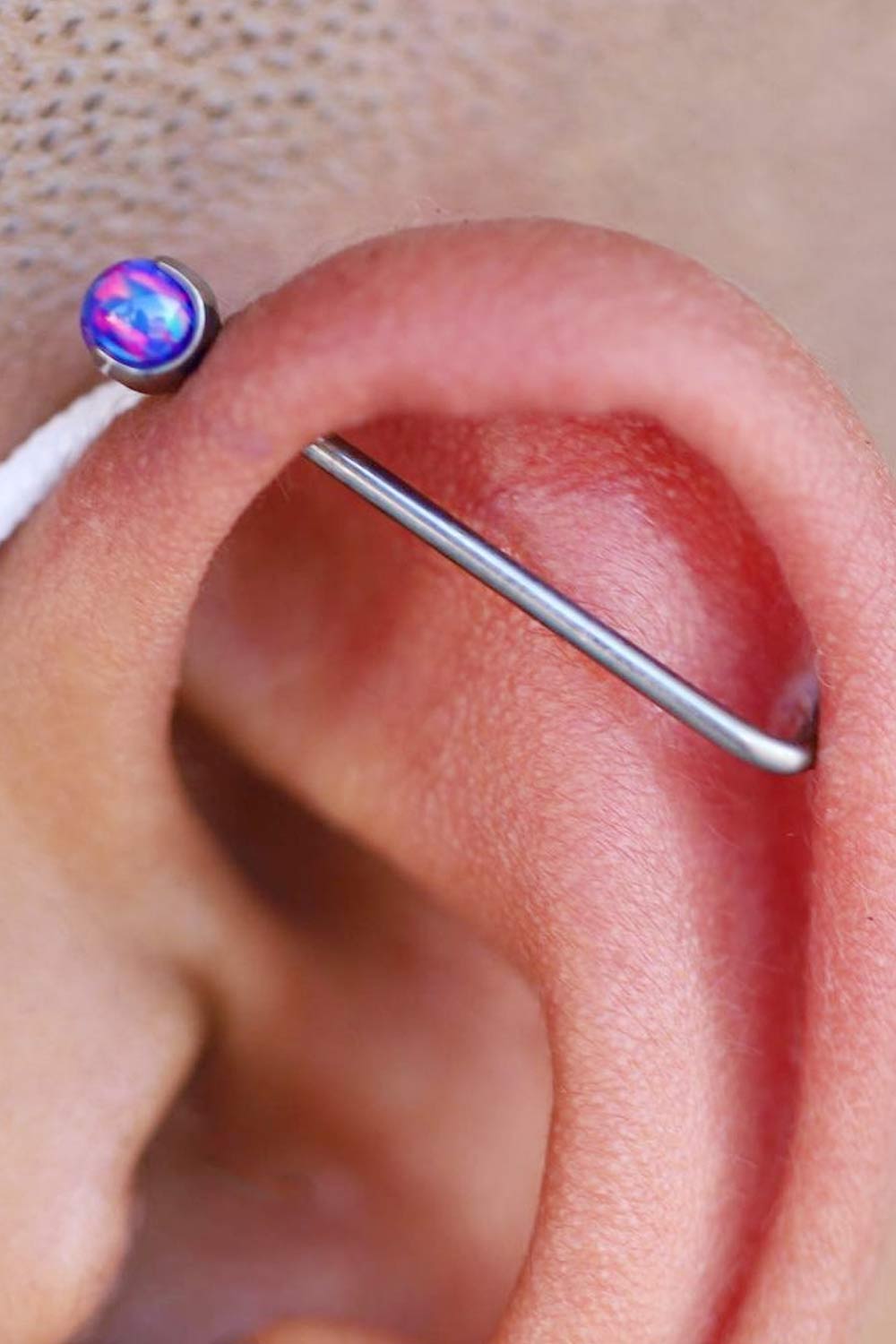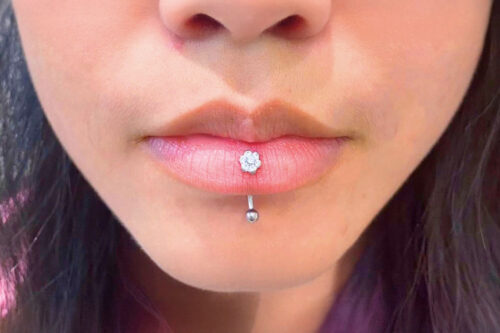It has become very common nowadays to get a piercing in different parts of your body with an industrial piercing being one of the most popular. This comes as no surprise though, as it offers you a number of advantages. In addition to looking cool and stylish, it also heals relatively fast, especially compared to other body piercings. What is more, it is always on display, so it will not take you much effort to show it off. A wide variety of jewelry options is another benefit you get. Ready to get your ears pierced? Here is what you should know about industrial piercings.
*We may earn money from affiliate links on this page. Please check out our disclosure policy for more details.QUICK NAVIGATION
- What Is An Industrial Piercing?
- Industrial Piercing Types
- Industrial Piercing Process
- Pain And Healing Of Industrial Piercing
- How Much Does It Cost?
- Industrial Piercing: Aftercare
- Industrial Piercing Jewelry Options
- Jewelry Materials For Industrial Piercing
- Industrial Piercing: Side Effects
Short Info:
PLACEMENT: On the upper ear
PRICING: $30-100 + jewelry
PAIN LEVEL: 5-7/10, but it varies greatly from person to person
HEALING: Between four to six months
AFTERCARE: Clean your piercing with a saline solution at least twice a day. Let it air dry.
What Is An Industrial Piercing?
by Kathy Hutchins/ShutterstockBut what is an industrial piercing in the first place? Simply put, you can call any type of ear piercing industrial when it implies connecting two piercings with one barbell. To get the cartilage pierced, the piercer should use a needle. It has other names though, such as a scaffolding and bar piercing. An industrial piercing suggests getting two piercings in your cartilage – one in the outer ear, which is also known as the helix and the other one in the inner ear, aka the forward helix. The distance between the piercings is usually about 1.5 inches. Piercing is not something you should skimp on, especially industrial. So, make sure to entrust this task to a professional. Industrial piercing is also popular among celebrities, such stars as Miley Cyrus, Willow Smith, Ashley Tisdale and Kylie Jenner were wearing industrial piercing.
Which industrial piercing style captures your aesthetic?
Anonymous quiz
- Classic Barbell Industrial
- Ornate Chain-Linked Industrial
- Colored Gemstone Accent Industrial
- Celestial-themed Industrial
- Minimalist Double Industrial
Vote to see results
Which industrial piercing style captures your aesthetic?
Industrial Piercing Types
Everyone knows that industrial piercing is very stylish, edgy, and unique. However, not everyone knows that there's more than one type of industrial piercing. Let's discover all of them together, shall we?
- Classy industrial: It is the most common type. Thus, it is often referred to as traditional industrial piercing. A piercer will take a straight barbell through your upper ear cartilage, so there are two points of entry.
- Vertical industrial: This type of piercing is quite similar to a traditional one. The only difference is the positioning – the barbell goes vertically through the ear's cartilage and aligns with it.
- Scaffold piercing: The only feature that differentiates this industrial piercing from the classy variant is the length of the barbell. It is usually a lot longer so that it covers more of your ear.
- Twisted industrial: The process and the placement remain the same, but a spiral-shaped barbell is used instead. Such an approach ensures a more eye-catching look.
- Triple industrial: This type of piercing involves three piercing holes instead of classy two entrance points. All three piercing holes are connected with the same barbell.
If case you can't make up your mind as to which option to choose, it is best to consult the piercer so that you can figure out which type would suit you best.
When considering an industrial piercing, it's essential to consult with a professional piercer to determine the most suitable type based on individual anatomy and preferences.
Industrial Piercing Process
Every type of piercing requires a well-defined procedure so that you end up with a safe and precise outcome. Here's what you should expect during an industrial piercing procedure:
- Consultation: Schedule a consultation with the expert before you book the procedure and ask all the questions you have on your mind. You may even inquire about which type suits your anatomy best.
- Placement: A trained expert will have a close look at your ear anatomy to figure out the best placement for the chosen industrial piercing. Horizontal and vertical industrial piercings are the most common variants.
- Sterilization: A skilled professional will clean the ear area with an antiseptic to avoid infection.
- Marking: Before piercing, the artist will mark entry and exit points for you to look at and make potential changes before the actual procedure.
- Numbing: This is an optional step since most people don't require it. However, an expert piercer may offer to numb the area to decrease the discomfort during the procedure.
- Piercing: The piercer uses a sterilized needle to pierce the cartilage.
- Jewelry: After the piercing, the artist will insert a barbell through the piercing points and secure the jewelry in place with screw-on beads.
- Final check: The piercer will inspect the outcome to align the barbell if needed.
- Aftercare: A skilled professional will provide all the necessary aftercare instructions. Including but not limited to the cleaning process, certain precautions, jewelry warnings, and so on.
- Healing: Usually, it takes up to a few months for an industrial piercing to heal properly. You must stick to the advised aftercare routine to speed the process up.
Usually, it takes up to a few months for an industrial piercing to heal properly. You must stick to the advised aftercare routine to speed the process up.
People Also Ask...
How painful are industrial piercings?
Why is the industrial piercing the most painful?
Can you sleep on an industrial piercing?
Pain And Healing Of Industrial Piercing
When deciding on whether to get your cartilage pierced twice or not, how much it is going to hurt is one of the most contributing factors for many people. So, if you are one of them, here is what you should know about industrial piercing pain. As it is done quickly, it will feel like a puncture. However, because you need two holes and they are made in the cartilage, not a lobe, it is going to be more painful than a regular piercing. That is to say, it majorly depends on your pain threshold.
As soon as the piercer takes the needle out, the hole is going to be a little sore. However, you should not feel a burning or sharp pain at this stage, which means that the healing process has started. Talking of healing industrial piercing may take from four months to half a year to heal or sometimes even longer. Your immune system and how thoroughly you will take care of it afterward affect the healing time greatly. So, be patient and it will surely pay you off.
How Much Does It Cost?
So, how much is an industrial piercing? As we already mentioned, this should not be the determining factor when it comes to the choice of the place where you are going to get it. However, it is worth mentioning that the industrial piercing price consists of the cost of the piercing itself and the jewelry. Thus, an average industrial piercing cost ranges from $30 to $70 for the service and from $1 to $100 and more for jewelry. Other points that affect how much does an industrial piercing cost are the place where the piercing salon is located, the level of expertise of the piercer and many others.
Industrial Piercing: Aftercare
Aftercare is very important for successful industrial ear piercing healing. Because it involves two, not one, holes, which you join with a barbell, it calls for more time and effort to take care of. So, you should make sure to follow all the aftercare advice that your piercer gives you. However, if you have already had other piercings, you may know some basic routine. For instance, you need to clean the holes daily using saline. Make sure you do it with clean hands though, as you do not want bacteria from your fingers to get into the wounds that are still open. But be careful, do not press too hard or otherwise damage the piercings, as this will extend the healing time. That is also why you should avoid sleeping on them at all costs. Removing the barbell earlier than required may result in infection or hole close up.
Industrial Piercing Jewelry Options
The most basic and common type of industrial piercing jewelry is a barbell. It is essentially a connecting bar that is inserted into two piercings and secured on the ends with removable beads, which is why it is also known as an industrial bar piercing. The bar is typically made of rose or yellow gold or implant grade titanium. Its length varies depending on the distance between the holes while the most popular size is usually 14 gauge. Yet, other size options, such as 16 gauge and 18, are also quite common nowadays. However, it should not always be straight. You can customize it to your taste.
Jewelry Materials For Industrial Piercing
There are three most common material types used for industrial piercings, as follows:
- Stainless steel (implant grade). The majority of piercing jewelry is made of stainless steel and no wonder. It is affordable, fuss free and offers a wide variety of styles. Keep in mind though if you have a nickel allergy, this metal will not work for you, as it can cause skin irritation and rash.
- Although gold piercing jewelry comes with a big price tag, if you have a few dollars to spare, this is a great option. While you can choose from white, yellow and rose gold, it should not be lower than 14 karats.
- As it does not contain nickel, your skin will not get irritated from wearing titanium jewelry. In addition to being quite light, it is not prone to corrosion and tarnishing. Besides, its color range is pretty wide.
Industrial Piercing: Side Effects
Of course, like any other intervention in your body, industrial piercings have a few side effects, namely:
- Infected piercing. Infected industrial piercing is a quite common issue. However, if you take care of the piercing properly after you get it done, you will most likely be able to avoid it. If your piercing remains red for too long, it is swollen, tender or itchy or there is discharge (green or yellow) from it, this may mean that it is infected. It will be sore and red at the beginning, which is fine. But the pain should not be intense or burning.
- Keloid scars. Keloids may appear on the sites of the piercing and be quite noticeable. This is how your skin responds to the injury. Yet, not only do they look unattractive, but they can also cause pain. Thus, you should not ignore them. The good news is they can be treated with injections of cortisone or removed surgically or using a laser.
- Rejected piercing. Sometimes, our body rejects piercing, as it considers it a foreign body. So, it wants to get rid of it. As it is trying to force the piercing out, the hole is beginning to heal. There is hardly anything you can do about it. Just to help the skin recover faster, you should ask a specialist to remove the piercing.
- The piercing holes can be surrounded by bumps, which are a sign of irritation. This may happen if you tend to touch the piercing or you have an allergy to its metal. Make sure to keep an eye on it. Change the jewelry if needed and do not touch the piercing without the necessity.
Now that you know everything about industrial piercing, all you have to do is to decide on the area that you want to get pierced as well as the type of piercing and jewelry you are going to get. And do not forget that finding your piercer is equally important. With all the information in mind that we have provided to you, you are guaranteed to end up with the result you want.
REFERENCES:- An industrial piercing (North America), also known as a scaffold piercing... Source
- Everything you need to know about the industrial bar piercing. Source
Was this article helpful?



